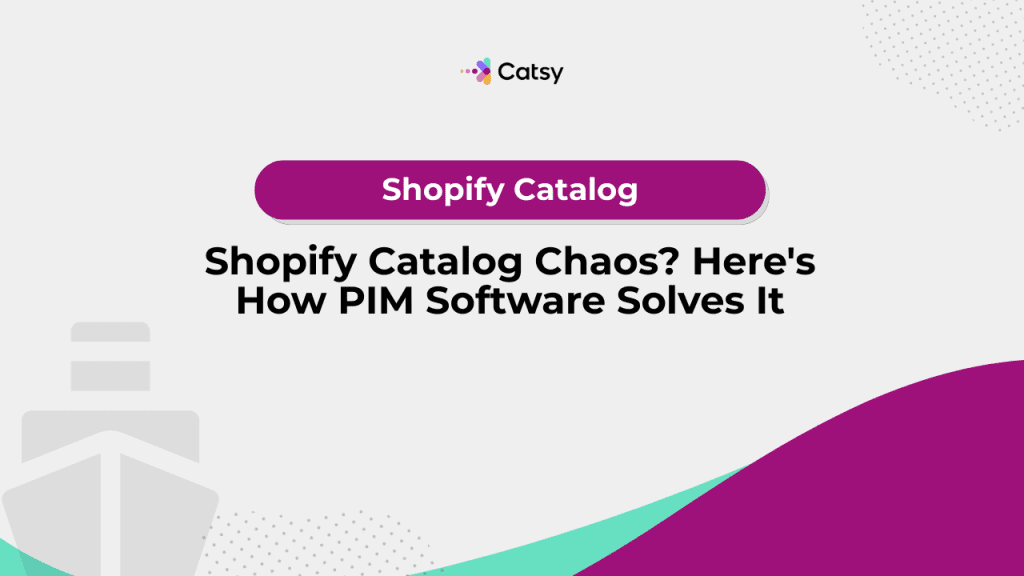Shopify Catalog Chaos? Here's How PIM Software Solves It
Struggling with product catalog chaos on Shopify? Learn how PIM software brings order, consistency, and automation to your product content management.

Table of Contents
- Introduction
- Understanding Catalog Chaos on Shopify
- The Real Cost of Disorganized Catalogs
- What is PIM and How Does It Help?
- How PIM Restores Order to Shopify Catalogs
- Real-World Use Cases: From Chaos to Clarity
- Why Catsy is the Ultimate Solution for Shopify Catalog Management
- Conclusion
What You Will Learn
- The common causes and consequences of product catalog chaos on Shopify
- How Product Information Management (PIM) systems solve these problems
- Practical examples of how PIM brings consistency, automation, and efficiency to your business
- Why Catsy is the ideal PIM solution for Shopify merchants with growing product data
- How to transform catalog chaos into a streamlined, scalable operation
In this Article
1. Introduction
In the vast sea of e-commerce, your Shopify catalog is your ship’s engine. Without precision and order, you’re dead in the water.
Many merchants still feels as though they’re sailing through a storm of disconnected spreadsheets, conflicting data, and manual edits… just to stay afloat.
This is catalog chaos: a tangled mess of incomplete attributes, inconsistent naming, outdated pricing, and misaligned product versions across channels.
But avast! There’s a lighthouse in the fog, called product information management. Product Information Management software for Shopify is the strategic navigational tool that brings clarity and control to your Shopify operations.
In this guide, we’re going to explore the most common catalog management issues that store owners like you face, and we’re going to show you how PIM software like Catsy can help you weather the storm.
2. Understanding Catalog Chaos on Shopify
a. Inconsistent Product Information
When your product titles, descriptions, or even dimensions vary across yourShopify stores, your customers lose trust in your brand. It’s that simple. Confusing data can be off-putting to your customers… and your own internal teams!
b. Missing or Incomplete Attributes
Have you ever launched a product, only to discover later that it’s missing the size or material? Incomplete data can tank your SEO rankings and bomb your customer satisfaction.
c. Manual Errors and Spreadsheet Mayhem
Far too many Shopify merchants rely on chaotic spreadsheets like Google Sheets to manage their catalogs. That’s fine for a while! But as your business grows, so does the chance for copy/paste errors, duplicate SKUs, and other version control nightmares.
d. Disconnected Tools and Channels
From email sales funnels to Amazon listings, disconnected tools pave the way for duplicated efforts and, ultimately, inconsistent content. Just one missed update within a single tool can result in brand erosion.
Make Catsy DAM and PIM Software an Extension of Your Team
Book a Free Demo3. How PIM Impacts SEO for Shopify Product Pages
a. Poor Customer Experience
Inconsistent information across your sales channels causes buyer confusion. Shoppers bounce when they can’t find clear answers to their product-related questions, and this leads to cart abandonment and support tickets.
b. SEO & Conversion Losses
According to Semrush, SEO optimized product data plays a critical role in organic rankings. If your product pages are disorganized, that translates to missed opportunities for organic traffic.
c. Time Drain and Operational Overhead
Merchandising, marketing, support, and e-commerce teams all spend hours chasing down data and making manual edits. Obviously, this reduces your organization’s bandwidth for focusing on your strategy.
d. Revenue Leakage
Incorrect prices, poor listings, and duplicate content across your sales channels lead to lost sales. In fact, disorganized catalogs are one of the biggest killers of Shopify profitability.
4. What is PIM and How Does It Help?
a. The Role of PIM in Shopify Stores
Product information management systems (PIM) centralize and manage your product data. From titles and descriptions to specs and currency, a PIM keeps your ship on course.
PIM creates one central hub for your product data, so every channel pulls from a unified, validated source.
b. The “Single Source of Truth” Advantage
Your PIM system serves as your product content control tower. Rather than juggling different versions of your data across multiple platforms, your team can collaborate in just one place. You retain full visibility and governance.
5. How PIM Restores Order to Shopify Catalogs
a. Data Centralization and Structure
PIM organizes your catalog with defined data models, attribute inheritance, and version control. Category and sub-category logic enhance this organization.
When you standardize your product taxonomy, search filters and navigation become clearer for your customers. Plus, your internal processes are more efficient… say hello to happier team members!
b. Automation of Enrichment and Updates
Rather than manually editing product content, a PIM allows you to:
- Apply templated product descriptions
- Auto-populate metafields or variants
- Schedule batch updates across entire product sets
This eliminates redundant work (saving you payroll hours) and accelerates your time to launch.
c. Validation and Governance
PIM systems enforce content quality with validation rules like:
- Mandatory fields
- Minimum or maximum character counts
- Duplicate detection
- Attribute formatting rules
This validation reduces human error and ensures every product meets each channel’s publishing standards.
d. Multichannel Consistency
With built-in syndication tools, PIM ensures that your Shopify catalog matches your content, no matter where you list. Amazon, Walmart, retail partners, and social media listings appear consistent, ensuring brand alignment across each.
6. Real-World Use Cases: From Chaos to Clarity
a. DTC Brand Eliminates Spreadsheet Bottlenecks
A direct to consumer Shopify brand was managing 3,000 SKUs across five team members … using spreadsheets. Data discrepancies were causing major daily fulfillment issues and customers were initiating support tickets.
With Catsy, they:
- Centralized all data into structured templates
- Built validation rules for required attributes
- Automated product updates to Shopify and email campaigns
Result: An 80 percent faster product launch process.
b. B2B Distributor Cleans Up Complex Product Variants
This business to business distributor sold multiple variations of industrial parts. Overlapping SKUs and conflicting tech specs were causing problems. PIM helped by:
- Structuring SKUs into families
- Using attribute inheritance
- Validating all specs before publishing
Result: A dramatic drop in customer complaints and returns due to incorrect specs.
c. Shopify Store Owner Syncs Channels Seamlessly
A fashion merchant sold on Shopify, Instagram, and Amazon. They used Catsy PIM to manage their product content from one unified dashboard. With these syndication tools and templates, the business maintained a persistent brand voice, accuracy in inventory, and consistent pricing.
Result: Three times faster content updates across all channels.
7. Why Catsy is the Ultimate Solution for Shopify Catalog Management
a. PIM + DAM Integration
If you’re excited about Catsy’s PIM capabilities, just wait until you hear about our DAM system. DAM (digital asset management) means that all your product images, videos, documents, PDFs and graphics are stored right there alongside your data.
DAM will:
- Link media to SKUs
- Auto-generate alt text
- Manage file versions and usage rights
No more hunting for assets across chaotic spreadsheets!
b. Seamless Shopify Connector
Catsy’s Shopify integration pushes enriched product content, images, and metafields directly to your Shopify store. It supports:
Catsy integrates seamlessly with Shopify to push enriched content and images directly to your storefront. Our platform supports bulk updates and variant management, and automatically syncs with Shopify Markets.
c. Channel Templates and Workflow Automation
Catsy includes prebuilt export templates for platforms like:
- Amazon
- Walmart
- Target
- Email campaigns
- International Shopify storefronts
Customize once, apply infinitely, all while eliminating duplicated effort.
d. Role-Based Collaboration
Merchandisers, marketers, and managers can all work simultaneously in Catsy! Assign tasks, set approval workflows, and just move faster… without stepping on each other’s toes.
8. Conclusion
Does your Shopify catalog feel like it’s been patched together with duct tape? Are you still updating your channels with manually generated spreadsheets? Stop!
PIM software brings order, control, and efficiency to your product operations. It creates a single source of truth that helps you publish with confidence and scale with precision.
With Catsy, Shopify merchants get a complete product content command center that was purpose-built to turn catalog chaos into clarity.
Set your sails. Unify your catalog. Scale with Catsy.
9. Key Takeaways
- Shopify catalog chaos stems from inconsistent data, manual processes, and disconnected systems
- PIM software centralizes product information into a structured, validated environment
- PIM ensures accuracy, accelerates product launches, and improves cross-channel consistency
- Catsy PIM + DAM offers Shopify merchants a scalable platform for catalog content management
- Real-time Shopify integration, workflows, and media tools streamline operations at every level
Want more tips, tutorials, and insights on product content and e-commerce operations?
Stay connected. We post regularly to help brands like yours scale smarter.
Are You Ready To streamline your product content management?

10. Frequently Asked Questions
Catalog chaos refers to disorganized, inconsistent, or incomplete product data that may be spread across multiple tools, spreadsheets, or platforms. This can result in operational inefficiencies, errors, and reduced trust in your brand.
A PIM will store and validate your product content in a centralized location. It enforces data quality through validation and workflows, and it syndicates your content across multiple channels. Whether you use Shopify, Amazon, or other platforms, you can be assured of consistency.
Catsy was built with Shopify merchants like you in mind. It provides direct integration which means you can edit in bulk, validate, and manage assets all in one platform. Channel-specific export templates make it easy to scale to multiple sales channels.
Yep! Shopify’s metafields are lacking for businesses wishing to scale. Catsy supports complex variant logic, inheritance, and Shopify metafields. This allows for detailed, structured catalog content management.
Yes, especially if you have a large or growing catalog. Even on just one channel, PIM reduces your manual effort, ensures SEO optimization, and allows you to scale.
Subscribe For More Content
Sign up for monthly tips on how to drive revenue with product content.




